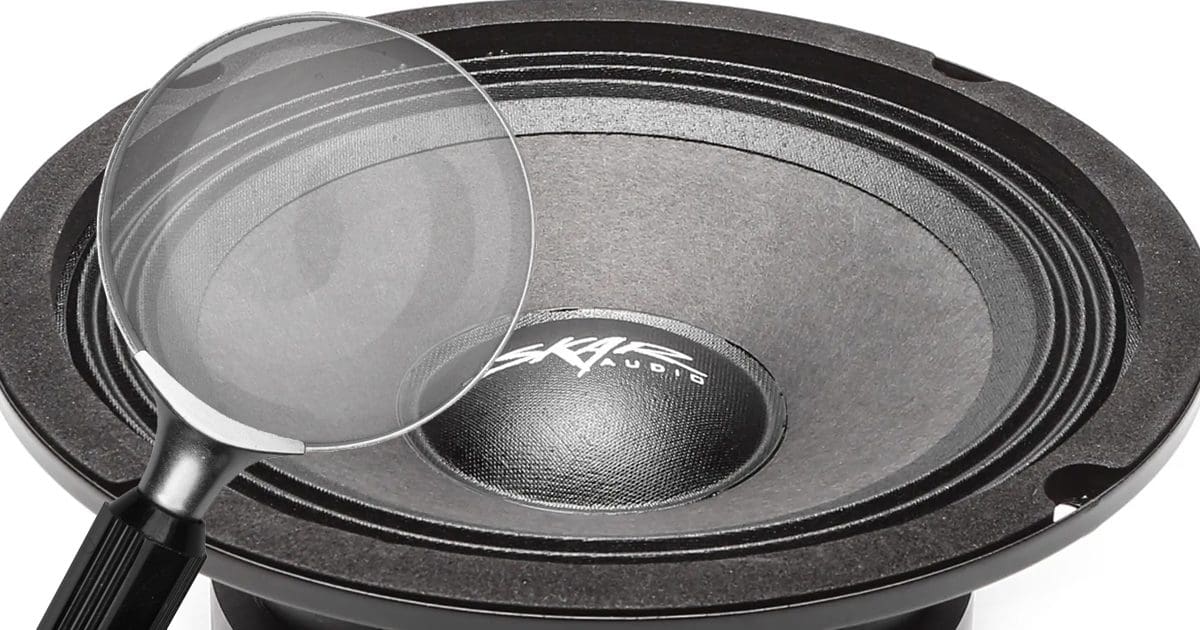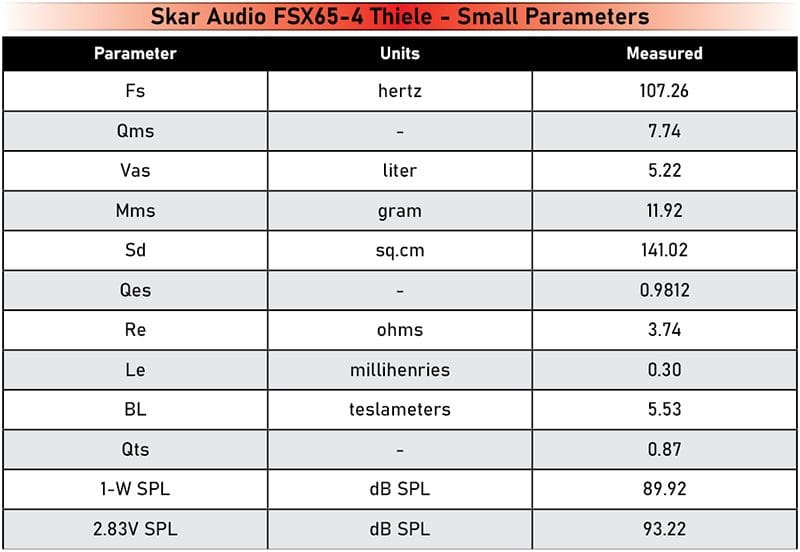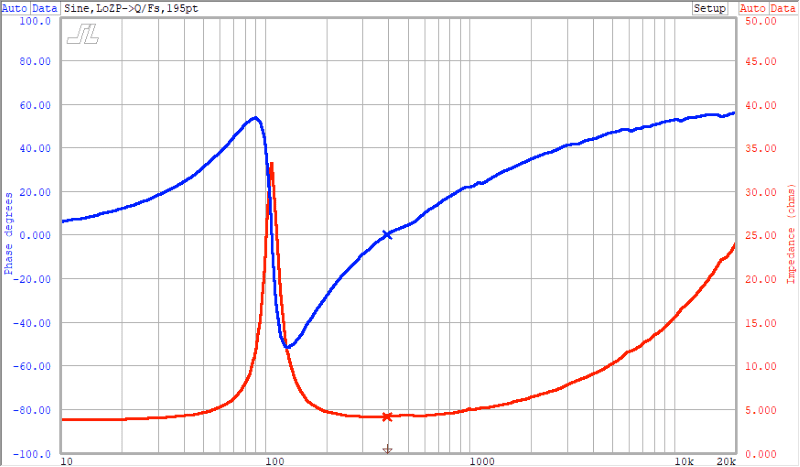We’re on to our third article in our series of quantifying speakers’ performance in terms of their application and quality. We started with a factory Honda speaker, then looked at what an inexpensive aftermarket speaker offered. For this third article, we’ll look at another inexpensive aftermarket speaker, the Skar Audio FSX65-4.
Skar Audio FSX65-4
Let me start by saying that in most cases, we’d never look at a speaker from a brand such as this one. As part of our mission, the goal of BestCarAudio.com is to promote the efforts of professional brick-and-mortar retailers and the brands that support them. With that said, I chose this speaker for two reasons: it’s inexpensive, and it’s a PA-style driver. The number of car audio enthusiasts who think these high-efficiency speakers are a direct drop-in replacement or upgrade for a factory speaker is baffling. These products are for an entirely different application and require a different system design that includes a separate midbass speaker. As such, this is a perfect candidate for our series on measuring speaker quality and system suitability by analyzing distortion at different drive levels.
The FSX65-4 is a 6.5-inch woofer based on an unreinforced stamped steel basket and ceramic magnet. It has a 4-ohm voice coil winding. The driver uses an untreated paper cone with a pleated textile surround. The lack of weatherproofing on the cone suggests these speakers aren’t suited for door applications. Skar Audio rates the drivers as capable of handling a continuous 150 watts of power and, more troubling, gives the speakers a frequency response specification of 100 to 8,000 hertz. We doubt they could handle 150 watts of power, and there’s very little chance of them playing down to 100 hertz with any amount of clarity. Nevertheless, that’s why we have it here – to test its capabilities and suitability.
Let’s start by measuring the Thiele/Small parameters of the speaker using the added mass method.
The most crucial piece of information we can learn from these measurements is that the driver has a resonant frequency (Fs) of just over 107 hertz. Most 6.5-inch door speakers have an Fs in the 60-80 hertz range. Part of the system design process is choosing a crossover frequency higher than Fs to avoid distortion. Without checking the distortion plots, we’d predict this driver would need a steep high-pass filter at nothing less than 150 hertz.
The impedance graph clearly shows a resonance at just over 500 Hz, 1 kHz and 2 kHz and 4 kHz. This doesn’t bode well for the driver offering low-distortion performance. In addition, the impedance spike at the resonant frequency is quite tall and reflects the Qts value of 0.87, which is well above what would be ideal for a “properly damped” driver. As such, this high Qts value will increase the distortion in the lower midrange.
Let’s import this data into BassBox Pro and look at the predicted frequency response of the driver in an effectively infinite baffle application with a 3-cubic-foot enclosure.
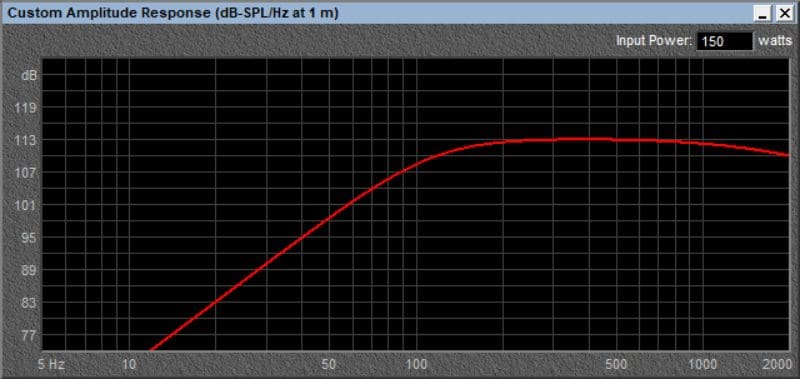
More information must be provided about this driver’s excursion capabilities to predict its suitability. Unfortunately, the lack of detailed information is common among companies that focus on price instead of performance. We’ve talked about this at length in this article. Without this information, we have to guess at the Xmax of the driver or cut one apart to measure the top plate and voice coil height. We plan on torture-testing this speaker later, so maybe we’ll pull it apart after that.
The frequency response graph doesn’t look terrible. In our test enclosure, the -3 dB frequency is 114.8 hertz, further reinforcing that this is a midrange speaker and not a woofer or midbass driver. The voice coil inductance is low enough that the top end doesn’t roll off too quickly, so that’s good.
Acoustic Frequency Response and Distortion Measurements
We set the Skar woofer up in our test enclosure and placed the microphone from our Clio Pocket at 12.5 cm or 4.92 inches from the mounting baffle. This isn’t an arbitrary distance. It represents 1/8 of the usual 1-meter test distance. I chose this distance because it makes it easy to calculate the 1W/1M efficiency, and it helps prevent reflections in the room from affecting the measurements. To convert the measurements into 1W/1M measurements, you can subtract 18 dB from the 1-watt measurement.
I performed a series of frequency response sweeps at different power levels, and we’ll compare the measured response and the harmonic distortion added to the output. Harmonic distortion from a speaker is an important concept. It describes how much more audio information the speaker produces than the signal we send. To understand the idea, let’s imagine we send a pure 1-kHz tone to the speaker, and it produces an acoustic output of 113 dB SPL at 1 kHz at the tip of the microphone. It might also create 71 dB at 2 kHz and 77 dB at 3kHz. These second and third harmonics are distortions that the speaker has added as a result of issues with its design. This isn’t content in our music or audio information sent to the speaker. In essence, the speaker itself made it up out of thin air.
The graphs we’ll look at below show the fundamental output of the Skar speaker in black, then the amount of second-order harmonic information the speaker added in red, and the third harmonic information added in blue. The perfect speaker wouldn’t add any harmonics – but that speaker doesn’t exist. One last note: All the measurements are smoothed to 1/12-octave response to make the graphs easier to read. Unfortunately, this smoothing masked some vital information that we’ll look at after analyzing the harmonic distortion.
Let’s start by feeding the speaker a frequency sweep at a level of 0.1 watt.
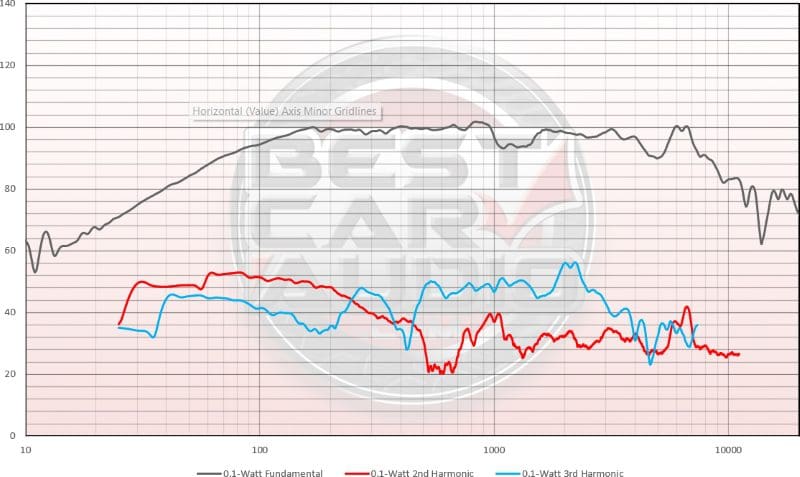
This graph shows us that the driver has an impressively flat output from 165 hertz to just under 1 kHz. There’s cause for concern with a 6 dB dip in output from 1.0 to 1.5 kHz, then the driver is relatively flat in output again to about 4 kHz. We’d think this was pretty good if we only looked at the driver’s frequency response. Looking at the two harmonic distortion traces tells us the driver isn’t adding too much unwanted harmonic information. Considering we’re only feeding the speaker 0.1 watt of power, this is a good thing. Nevertheless, we’ll need to keep an eye on a small bump in second-order harmonics around 1 kHz and a bump in third-order harmonics around 2 kHz.
Let’s up the power level to 0.316 watt, representing an increase in output of about 6 dB SPL.
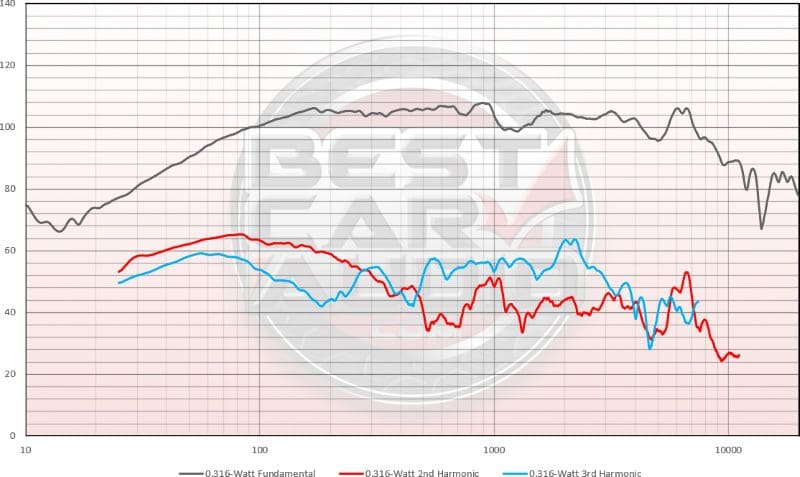
The output of the speaker increased linearly with the increase in power. This indicates there aren’t any significant limitations in excursion affecting performance. Once again, at only 0.316 watt of power, we’d hope not. One thing we overlooked in the last chart was the amplitude of the low-frequency harmonic distortion. At the 0.316 drive level, the second-order harmonic content at 100 Hz is at 0.67% (94.4 dB SPL compared with 51.2 dB). That’s pretty bad in the grand scheme of things and reinforces that this driver is not suitable for use as a woofer playing audio frequencies down to 100 Hz or below. Our two peaks at 1 kHz and 2 kHz haven’t changed much.
Let’s increase the power to the speaker to 1 watt and measure again.
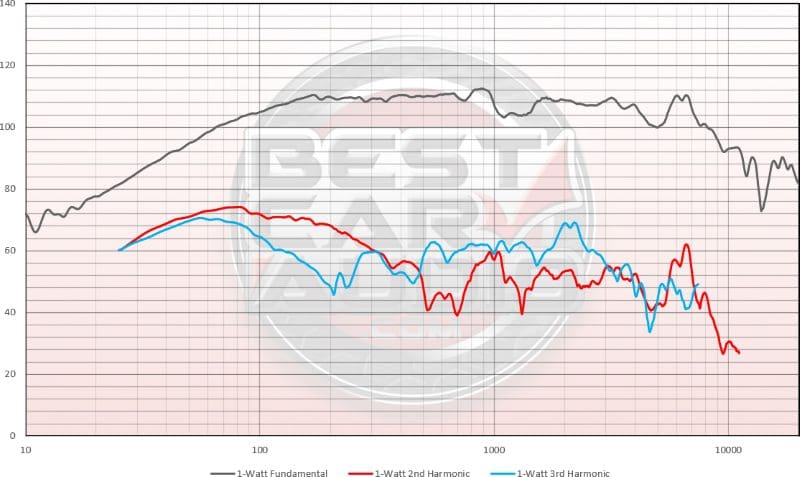
We can look at the speaker’s efficiency at this 1-watt drive level. If we subtract the 18 dB gain from having the mic close to the driver, we see it’s right at 92 dB SPL at 1W/1M. That’s pretty loud, but as we’ve explained in many articles, it comes at the cost of low-frequency output. We are starting to see a change in the relative level of the harmonic content. At lower frequencies, the third-order harmonics get louder. At 200 Hz, the second-order distortion is up to 0.81%. This isn’t going to do much for vocal clarity. If you want to drive this speaker with only 1 watt of power, the high-pass crossover should be set to at least 300 Hz. Yes, 1 watt of power. The distortion spike at 1 kHz has increased noticeably, representing 0.46% distortion.
Time to start getting loud. Let’s up the power to 3.98 watts and see what happens.
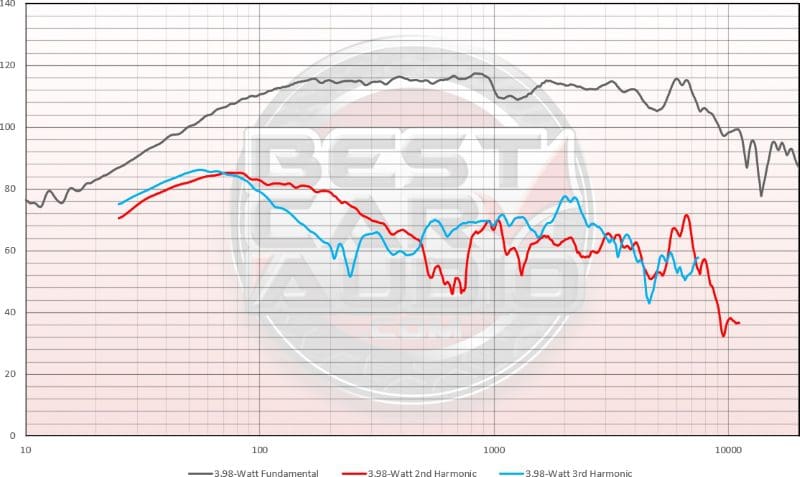
To be clear, you’d be surprised just how loud 4-ish watts of power is. This is just shy of 100 dB of output at a distance of 1 meter from the speaker. We’ve been wearing hearing protection since the start, of course. Looking at this new graph, we see that the frequency response is still acceptable, but the level of the second harmonic distortion in the 200-to-500-hertz region has increased by more than 6 decibels. At 200 hertz, we’re seeing 1.46% distortion; at 300 hertz, the second-order harmonic distortion is at 0.56%. The spike in third-order distortion at 2 kHz is up to 1.5%. That would sound pretty harsh. Again, this is with less than 4 watts going to the speaker.
Time to bump the power to the speaker to 15.85 watts of power. This is what a good-quality radio can produce.
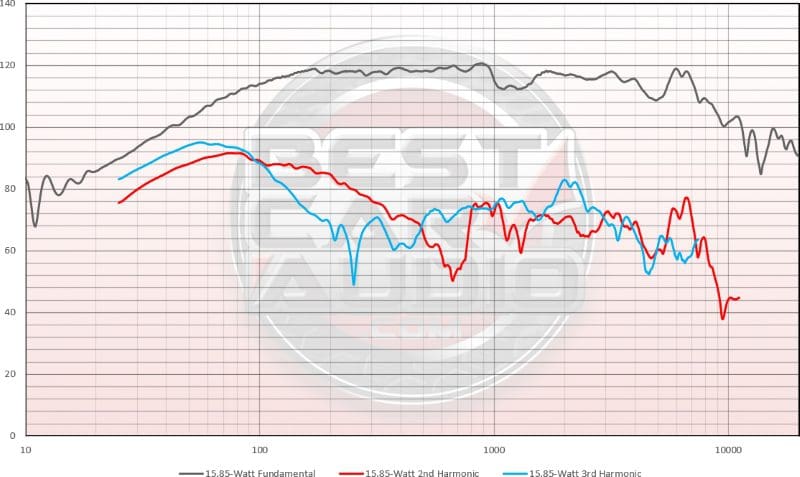
The frequency response changes appear linear, based on our 1/12-octave smoothing. However, we’ll look at the unsmoothed data after we’re done with the specific power level analysis. There aren’t any huge changes in distortion above 300 Hz at this drive level. However, the second-level distortion at 800 Hz is now a little worse than at 4 watts at 0.5%. This will make upper-midrange information sound harsher.
Let’s bump the power to what a small amplifier can deliver at a drive level of 31.7 watts.
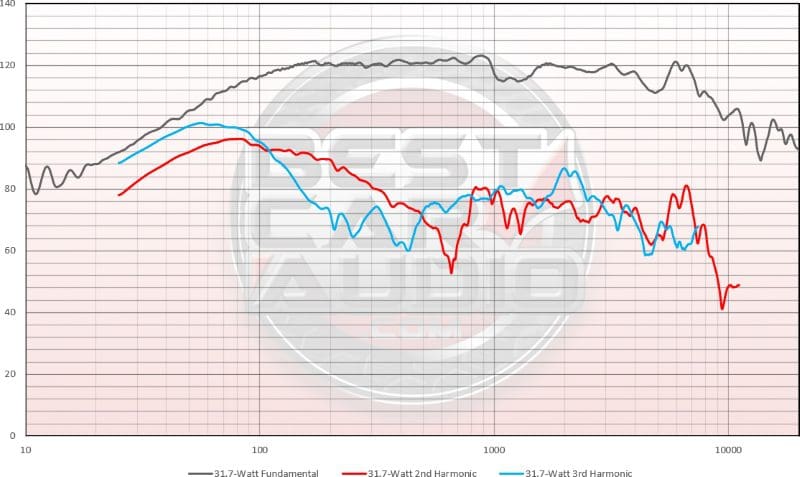
We didn’t increase the output by 6 dB for this measurement since we’re getting into significant drive levels. Lower-frequency distortion is becoming significant. At 200 Hz, we’re seeing a screeching 2.77% second harmonic, and at 300 hertz, it’s 0.97%. Nasty, just nasty.
Time for 63.1 watts of power.
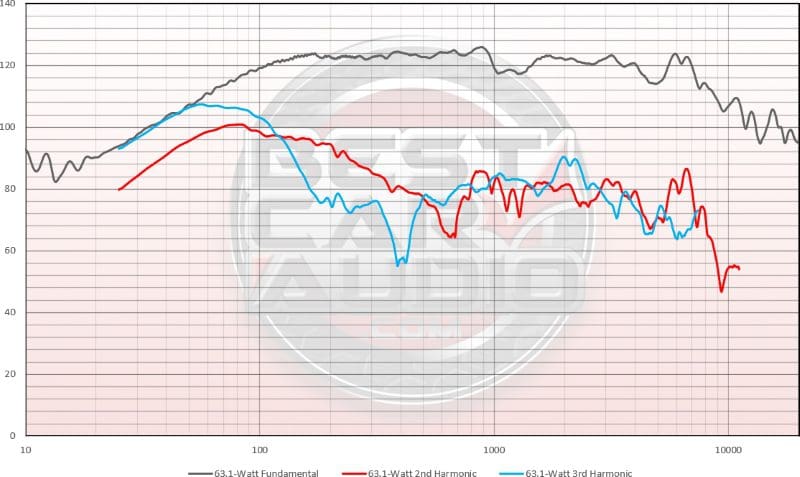
We only doubled the power this time, as it’s clear the speaker isn’t very happy. Interestingly, down at 50 hertz and below, the driver is producing 100% distortion. This means if you feed it a 50-Hz signal, it also produces a 150-hertz signal at the same amplitude. That’s gross! Second-order distortion is at 3.8% at 200 hertz and 1.27% at 300 hertz in the lower midrange. The third-order harmonic distortion bump at 2 kHz is at 2.5%. Looking closely at the frequency response from 100 to 300 hertz, you can see some small ripples in the chart. Keep those in mind.
OK, last measurement. Let’s drive the speaker with 126 watts of power.
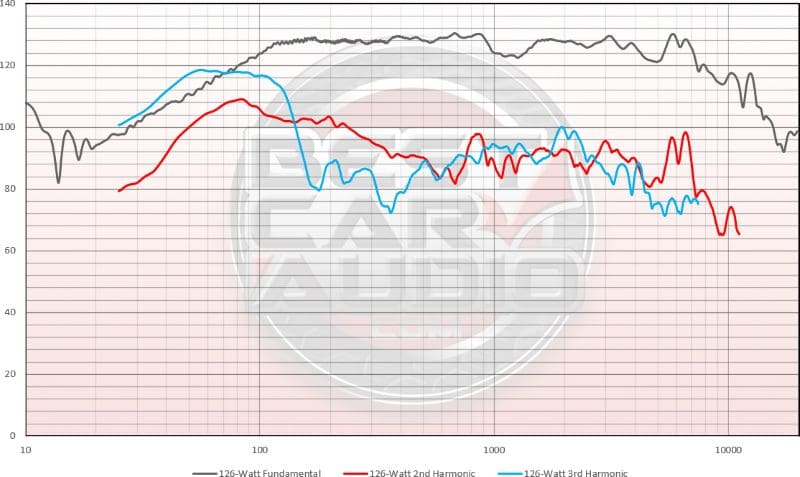
The distortion produced by the Skar Audio FSX65-4 is terrible across the entire audio range when driven with 126 watts of power. It’s at 5.5% at 200 hertz, 2.125% at 300 hertz and 2.39% at 850 hertz. If you have ever wondered why some speakers sound harsh when played loud, this is a perfect example of one that would do that.
So, how much distortion is acceptable? In amplifier testing, we shoot for 1% total harmonic distortion and noise to rate maximum power, but most brands provide a spec below 0.1%. If we used the higher number, the speaker would be “good” up to about 3 watts. It never produces less than 0.1% distortion, even with 0.1 watt of power. So much for the 150-watt power rating information being of any use or the 100-to-8,000-Hz frequency response spec telling us about the suitability of this driver. We’d suggest at least a 300-Hz high-pass filter if you want to prevent midrange distortion. Ignoring that big dip above 1 kHz (which would need to be equalized out of the system with a DSP), you could use the driver up to about 4 kHz.
Unsmoothed Frequency Response Analysis
As mentioned, we need to look at the raw unsmoothed frequency response of the speaker at different drive levels. The chart below shows the raw data measured by the Clio Pocket audio analyzer.
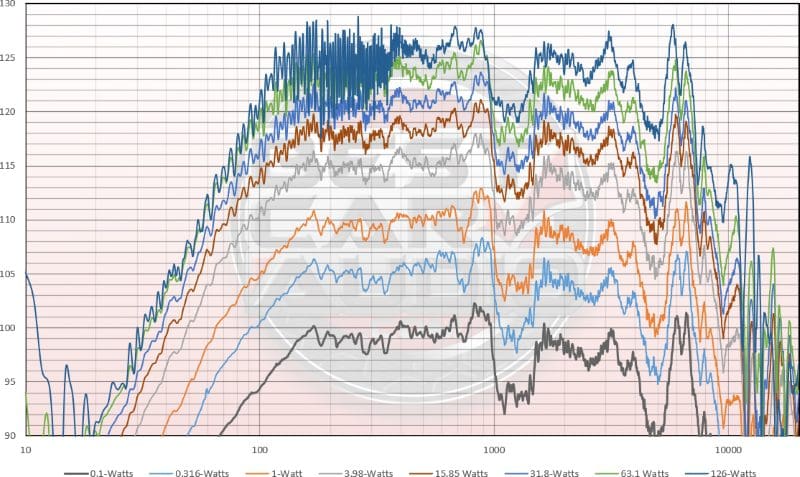
If you look at the first three measurements – 0.1, 0.316 and 1 watt – you can see that the graph in the lower midrange (<500 Hz) is pretty smooth. As the drive level increases to 4 and 16 watts, the measurement has some fuzziness. This is attributable to the increase in harmonic distortion added by the speaker. At 32 watts, it’s getting pretty bad. At a level of 63 watts, the fuzziness is a big issue. At 126 watts, the unwanted information below 400 hertz is a disaster.
Based on this information, we’d up our suggested crossover frequency to 450 hertz and wouldn’t drive the speaker with more than 30-ish watts of power. The distortion issues related to frequency and drive level limit the suitability of this speaker for any application where quality, accuracy or clarity is crucial.
Sadly, it’s nearly impossible to discern the actual quality of a speaker without an extensive set of measurements or a critical listening evaluation. This Skar Audio driver is a perfect example of how even moderate amounts of data, in this case, a frequency response graph, could be misleading without additional information. If you’re searching for high-quality speakers to upgrade your car stereo, visit a local specialty mobile enhancement retailer. Be sure to bring along some music you know well and listen to the speaker at different output levels.
